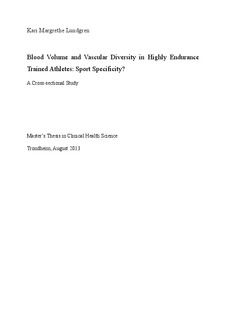| dc.description.abstract | Background: Blood volume (BV) is a critical component for cardiac output. However, it is
unknown to what extent a high BV contributes to explain differences in maximal oxygen
uptakes(VO2max) in elite athletes in different sports. Furthermore, efficient oxygen delivery to
working skeletal muscles challengesthe vascular system, and arterial changes are found in
athletes disposed to chronic endurance training. Whether these arterial changes influence the
arterial dilatory response in endurance athletes with different involvements of the upper,
lower and whole body is unclear. Objective:The aims of this study were to compareVO2max,
BV, hemoglobin mass (Hbmass) and vascular function in highly trained endurance athletes
primarilyusing whole (cross-country skiing), lower (orienteering) and upper body (flatwater
kayak). Method: 43 male endurance athletes in the disciplines of cross-country skiing (n=17),
orienteering (n=15) and flatwater kayak (n=11) participated in a cross-sectional study. VO2max
was measured using direct ergospirometry, carbon monoxide re-breathing method was used to
assess BV variables and endothelial function was measured as flow mediated dilatation
(FMD). Results: The cross-country skiers had higher VO2max than the orienteers regarding
mL⋅min-1
⋅kg
-1 and L⋅min-1
(p<0.01). The cross-country skiers and orienteers showed
significantly higher BV than the kayakers, both relative to body mass (p<0.05) and FFM
(p<0.01). The cross-country skiers had significantly higher Hbmassthan the kayakers relative
to body mass and fat free mass (p<0.05), with no significant differences between the crosscountry skiers and orienteers. The kayakers presented significantly larger arterial diameter
than the orienteers (p<0.05), but there were no significant differences between groups
regarding FMD. Conclusion:These data indicates that the whole body exercise employed by
cross-country skiers induces higher VO2max compared to upper and lower body sports.
However, thesedifferences did not correspond with variations inBV variables between crosscountry skiers, orienteers and kayakers. | nb_NO |
